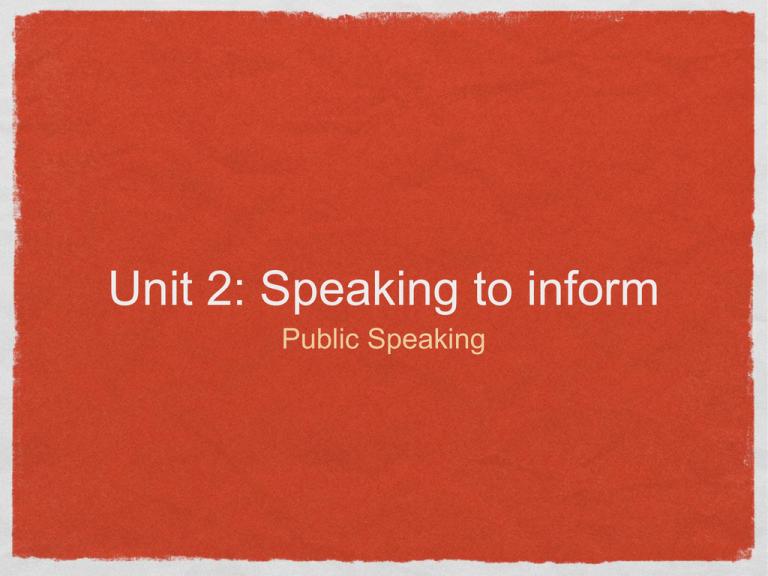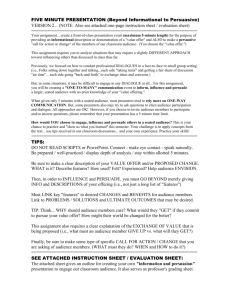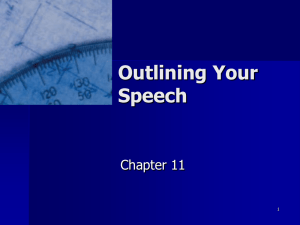informative or persuasive
advertisement

Unit 2: Speaking to inform Public Speaking Lesson #2: Purposes for speaking Question: The purpose for almost all speeches falls into two categories: speaking to inform and speaking to persuade. What are the differences between these two purposes? Speaking to Inform Speaking to Persuase You are the teacher/lecturer/expert. You are the advocate of a cause. Goal: Convey information in a clear, interesting, and accurate manner; enhance the knowledge or understanding of the audience. Goal: Change or structure the audience’s attitudes or actions; win over your listener’s point of view. Specific purpose A statement that focuses on one aspect of a topic. stated as an infinitive phrase indicates precisely what you hope to accomplish in your speech Topic: Baseball Cards General Purpose: To inform Specific Purpose: To inform my audience of the major factors that determine the value of a baseball card. Tips for formulating a specific purpose statement Write the purpose statement as a full infinitive phrase, not as a fragment Ineffective: Calendars Effective: To inform my audience about four major kinds of calendars used in the world today. Tips... Express your purpose as a statement, not a question Ineffective: What is a Quinceanera? Effective: To inform my audience about the origins, ceremonies, and importance for young women of the traditional Quinceanera celebration in Mexico. Tips... Avoid figurative language in your purpose statement. Ineffective: to persuade my audience that banning all fraternities because there have been hazing abuses at some colleges would be like throwing the baby out with the bath water. Effective: to persuade my audience that banning all fraternities because there have been hazing abuses at some colleges would punish the vast majority of the fraternities for the actions of a few. TIps... Limit your purpose statement to one distinct idea. Ineffective: to persuade my audience that the federal government should ban all cigarette ads and smoking should be prohibited in all campus buildings. effective: to persuade my audience that the federal government should ban all cigarette ads. Tips... Make sure your specific purpose is not too vague or general Ineffective: to inform my audience about the Civil War Effective: to inform my audience about the role of African American soldiers in the Civil War. Questions to ask about your specific purpose: 1. Does my purpose meet the assignment? 2. Can I accomplish my purpose in the time allotted? Is the purpose relevant to my audience? Is the purpose too trivial for my audience? Is the purpose too technical for my audience? The central idea... Reading passage in packet on page 6 Effective Ineffective Express as a full sentence. Although fad diets produce quick weight loss, they can lead to serious health problems by creating deficiencies in vitamins and minerals and by breaking down muscle tissue and fat. Problems of fad diets Avoid phrasing as a question. Played on a smaller, enclosed field that resembles a hockey rink with artificial turf, indoor soccer involves faster action, more scoring, and different strategies than outdoor soccer. How does indoor soccer differ from outdoor soccer? Avoid figurative language Mexico’s Yucatan peninsula has many attractions for vacationers, including a warmer climate, excellent food, and extensive Mayan ruins. The Yucatan peninsula is a sweet place for a vacation. Be clear and specific, not vague or general Art and architecture developed during the Renaissance period are recognized for their innovation and standing the test of time. The Renaissance was a period of prosperity and innovation. Organizing your ideas QUESTIONS: Why is it important that speeches be organized clearly and coherently? The ideal number of main points/supporting arguments in a speech is... Organization Method Chronological Order (informative) Explanation/Example Time pattern; beginning to end i.e.The building of the Great Wall of China began during the 4th Century B.C.; new sections were added between 221 B.C. and 681 A.D.; it was completed during the Ming Dynasty of 1368-1644. directional patterns: top to bottom, left to right, etc. Spatial Order (informative) i.e. The Eiffel Tower is divided into three sections: The lowest contains the entrance, gift shop, and restaurant; The middle sections consists of stairs and elevators that lead to the top; the top includes an observation deck. show cause-effect relationships Causal Order (informative or persuasive) Problem-Solution Order (persuasive) Topical Order i.e. The growing use of aging planes by U.S. airline companies threatens the safety of air travel; To meet the growing needs of air travel, companies are keeping older planes in service; if this trend continues it will create more problems for airline safety. Shows existence of problem; presents solution i.e. Drunk driving is a serious problem that can be reduced by the use of ignition interlock devices that prevent people with excessive blood-alcohol levels from starting their cars. topic that can be divided into subtopics i.e. The major types of fireworks are skyrockets, Roman TIPS FOR PREPARING MAIN POINTS Keep main points separate. Do not lump more than one supporting argument/main point together. Try to use the same pattern of working for main points. Regular exercise increases your endurance. Regular exercise improves your sleep pattern. Regular exercise helps control your weight. Balance the amount of time devoted to main points. Connectives In speeches we use CONNECTIVES, or words or phrases that join one thought to another and indicate the relationship between them. 4 TYPES OF CONNECTIVES 1.Transitions: words/phrases that indicate movement between thoughts i.e.: In addition, however, one example, another... 2. Internal Previews: Preview that lets the audience know the idea that is coming next i.e.: I will focus on three solutions--instituting tighter government regulation of credit bureaus, holding credit bureause financially responsible for their errors, and giving individuals easier access to their credit reports. Connectives (continued) Internal Summaries: remind listeners of what they just heard; used when a speaker finishes a complicated or important main point Signposts: brief statements that indicate exactly where you are in the speech i.e. The first cause of the... The second cause.... The third cause... The final contributing cause.... Beginning and ending a speech Question: What are some important things to do in an introduction of your speech? A conclusion? Objectives of an Intro Get the attention and interest of your audience. Reveal the topic of your speech. Establish your credibility and good will. Preview the body of your speech. Get attention and interest 1. Relate the topic to the audience. 2. State the importance of your topic. 3. Startle the audience (with an intriguing statement). 4. Arouse the curiosity of the audience. 5. Question the audience. 6. Begin with a quotation. 7. Tell an anecdote (brief, meaningful or entertaining story). Once you’ve gained interest, reveal the topic Don’t get so caught up in intriguing the audience that you forget to clearly introduce your topic! Credibility and Good Will Credibility: establish that you are qualified to speak on the subject matter Good will: show you are well-meaning and respectful of the audience’s viewpoints Tips for preparing your introduction Keep the introduction relatively brief. It should be no more than 10-20% of your speech time. Be on the lookout for possible introductory materials as you do your research. (startling statistic, quote, story, etc.) Be creative in devising your intro. Write a couple different options and see what you like best during your practice runs. Don’t worry about the exact wording of intro until you’ve finished preparing the body of your speech. Write out your intro in full, even if you do not do this for the rest of your speech. The purpose of the conclusion Let the audience know you are ending the speech To reinforce the audience’s understanding of, or commitment to, the central idea Ways to signal the end is coming use your voice--tone, pacing, intonation, and rhythm can all indicate closure Use concluding words (“In closing,”etc) Build up to the end--end on a climactic note Encourage thought in the audience Reinforcing the central idea Summarize or restate the thesis and main points End with a quotation Make a dramatic statement Refer back to a line in the introduction Sample intro/conclusion Commentary Separate handout..... Guidelines for Outlines State the specific purpose of your speech Identify the Central Idea. Label the Introduction, Body, and Conclusion Use a consistent pattern of symbolization and indentation State the main points and sub-points in complete sentences Label transitions, internal summaries, and internal previews Attach a bibliography. Give your speech a title.




